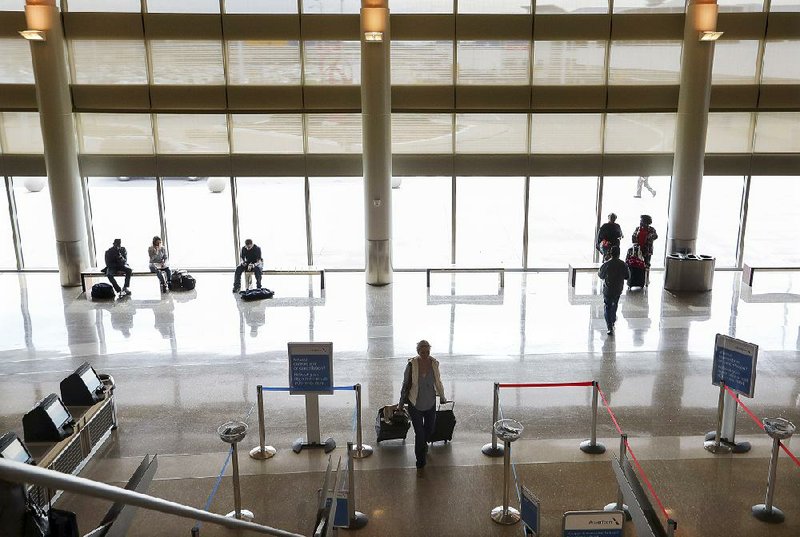The proposed 2020 operating budget for Bill and Hillary Clinton National Airport/Adams Field totals nearly $36.8 million, a 2% increase over this year's estimated $36 million operating budget.
The proposal assumes a 1.5% increase in passenger traffic and increases in landing fees and other fees the airport charges airlines to cover the costs of maintaining the airfield and terminal.
This year, passenger traffic was up 5.3%, to 1,874,435, through October compared with the 1,778,677 the airport saw in the first 10 months of 2018. But airport officials don't expect that rate of increase to continue.
Based on input from air service consultants, as well as input from the airport staff, the 2020 operating budget proposal includes an expectation that enplanements will increase 1.5%, according to budget documents submitted to the Little Rock Municipal Airport Commission. The budget assumes the airport will see 1,140,507 enplaned passengers in 2020.
The Clinton National staff proposes no increase in the cost for vehicle parking, the single largest source of income for the airport.
Parking revenue in 2020 is expected to total almost $10.3 million, which is 1.3% higher than the amount that parking is expected to bring in this year, accounting for 28% of the airport's annual operating budget.
Rates range from $8 daily in the economy lot to $13 daily in the short-term lots and parking deck.
Airline revenue is expected to total about $12.9 million in 2020, or 2.6% more than the $12.6 million Clinton National projects to receive in 2019.
The airport staff is proposing to increase landing fees, airline rents and facility use fees. The commission will vote on those increases Tuesday.
Clinton National's new executive director, Bryan Malinowski, said the proposed increases were designed to allow the airlines to slowly absorb the costs of future upgrades to the airport facilities "so you're not hitting them with a big whammy in five years."
Under the proposal, landing fees -- the $6.2 million estimate accounts for 17% of the proposed 2020 operating budget -- would rise to $4.26 per 1,000 pounds of landed weight. The airport now charges $4.21 per 1,000 pounds.
Rental rates for the airlines in the passenger terminal would rise to $44 per square foot, up from the $42.50 the airport charges now. The $5.9 million that Clinton National projects to receive from airline rents accounts for 16% of the proposed 2020 budget.
Other fee increases include the monthly aircraft ramp fee, which would rise to $1,590 from $1,500, and the remain-overnight fee, which would cost airlines $80 per turn, an additional $5 over what the airport charges now. The cost to use the jet bridges also would rise.
The additional $355,133 in revenue that Clinton National expects to receive includes not only the increased fees but also the increased landing weight the airport expects from additional passenger traffic, according to budget documents.
The fee increases would bring the airport's cost per boarding passenger, a key financial metric to measure airport performance, to $10.84, up from $10.67 in 2019.
Non-aviation revenue is expected to total nearly $23.9 million in 2020, a 1.5% increase over the expected total this year.
In addition to parking, a big driver in non-aviation revenue is car rentals. Those are expected to total nearly $4.9 million in 2020, a 1% increase over what the airport expects in 2019. That accounts for 12% of the proposed 2020 operating budget.
The proposed 2020 operating budget expects to see a total of $4 million from facility leases and ground leases. Together, the facility and ground leases account for 12% of the budget.
Revenue from terminal concessions is expected to total nearly $1.3 million in 2020. The total is flat compared with 2019. The projected increase in passenger traffic is offset by reduced concession fee rates for concession brands such as Chili's and Chick-fil-A.
Airport expenses, meanwhile, are projected to total $25.3 million in 2020, an 8% increase from the $23.4 million the airport expects to spend this year.
Salaries and wages for the airport's roughly 150 employees make up the biggest expense, totaling more than $8.9 million next year, an 8.6% increase from 2019.
Employee benefits are expected to total more than $4.7 million in 2020. The 15.6% increase in employee benefits compared with 2019 is primarily the result of medical insurance premium increases, according to the budget documents.
The airport is projecting to receive $14.5 million in non-operating revenue next year.
Non-operating revenue includes passenger facility charges, or the $4.50 the airport collects on each boarding passenger.
That money can be used to pay for projects approved by the Federal Aviation Administration that enhance the safety, security or capacity of the airport as well as reduce noise or increase airline competition.
Clinton National anticipates $7.9 million in federal, state and local grants next year.
The proposed 2020 budget would leave the airport with a change in net position of $7.9 million after accounting for depreciation and other charges.
Metro on 11/18/2019
